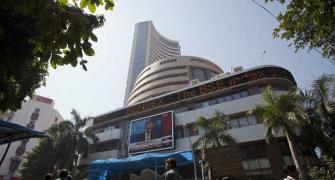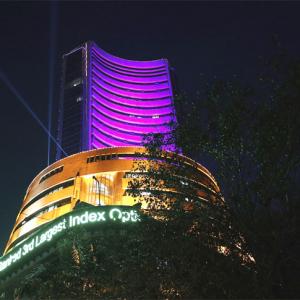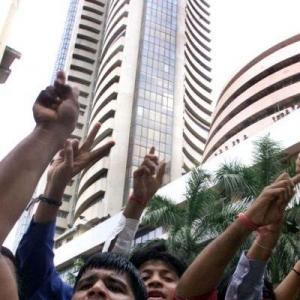As long as the RBI is given the space to do what it needs and the government can deliver on its promise to make India an easier place to do business, we are on a good wicket, says Akash Prakash.

I had the privilege to attend the recent Morgan Stanley Asia conference in Singapore. It is their flagship regional conference, and extremely well attended and organised.
At this same conference, for the last few years, there has been absolutely no interest in India. Indian companies were given the smallest presentation rooms, and even these were half full with mostly Indians in attendance.
The picture could not have been more different this time.
All the India presentations were in the biggest rooms and totally packed, mostly with foreigners.
Throughout every conference presentation, even the global and pan-Asian discussions, India was consistently mentioned (along with Japan).
There was genuine interest and excitement around India once again.
Everyone has rediscovered India's growth potential, and it is once again a secular story to buy and hold.
This excitement is understandable, India is the best performing equity market in the world (of size) in the year to date, up about 30 per cent in dollar terms.
It has also outperformed the emerging-markets benchmark by about 30 per cent.
In a world of secular stagnation, deflation and limited earnings growth, India is moving to a different beat.
We are a large domestically driven economy, with growth accelerating, inflation and interest rates falling, and corporate profitability below its mean and poised to improve.
India also has very little exposure to a possible China debt bust or a collapse of the yen.
Both these issues are weighing down most of the other large emerging markets, whether the North Asian countries or Brazil or South Africa.
There were, however, two issues on the mind of every investor. One, isn't India massively over-owned? Nobody wants to be the last person joining the party. Secondly, given how well the markets have done, isn't the country just too expensive? There seems to be no valuation margin of safety.
On the first point, it is true that India is well discovered and owned.
Whichever survey you look at, GEM (global emerging market) and Asian investors are overweight - at record levels - on the country, with weights between 400 and 700 basis points above their benchmark (60-100 per cent overweight).
It is unlikely that these investors can now increase weights further. In another survey that I saw, 80 per cent of the GEM funds surveyed were overweight India, higher than for any other country.
The fact that we have received equity inflows of only $15 billion year to date, compared to an annual average over $18 billion in the last two years (despite the surprise election result and decline in oil prices) points to a saturation among GEM and Asia investors for India.
The bulls point out that among global and international funds, there is far less ownership of the country.
This is where the incremental foreign capital will come from, once they start appreciating the secular attractiveness of India.
Discussions with sell-side analysts indicate that this process of discovery has begun, with record numbers attending the numerous India conferences.
The size of these global funds dwarf the GEM funds, leaving a substantial runway for continued inflows.
The more important offset to potentially subdued global flows is the domestic investor base.
After selling in an uninterrupted manner for more than five years, domestic institutions have now received inflows of more than $1 billion a month (for the last four months). I would not be surprised to see annual inflows of $15 billion from domestic investors over the coming years.
This is very important as it makes our markets far less dependent on foreigners, and also provides an offset to any selling by foreign institutional investors driven by global shocks.
While India is over-owned among its traditional investor base, there are many high potential new global investors and domestics who are underexposed and can still take our markets forward.
As for the second point, again data show the reason for concern.
With forward price-earning (PE) multiples between 15 and 17, India is trading at close to a record premium of 57 per cent to MSCI Emerging Markets, and about 10 per cent above its own 10-year average.
India has traded at a higher premium to emerging markets only two per cent of the time in the last 20 years. Indian returns on equity (ROEs), at 15 per cent, are also no longer at much of a premium.
There are two or three countervailing factors on the valuation front as well.
First, the PE multiples quoted above are on below-trend earnings, not peak-of-cycle. Margins (profit share of gross domestic product, or GDP) are still 30 per cent below the last 10 year averages, and nowhere near the last peak in 2008.
If one were to assume that margins normalise to the last 10-year average, and real GDP growth accelerates to seven per cent over the coming three years, one can easily see near 20 per cent annualised earnings growth for the market.
India may deliver the fastest earnings growth of any large emerging market. For all those investors using the PEG (PE to growth) ratio, the higher growth can justify the higher multiple.
It is also highly likely that interest rates and inflation in India will permanently settle at a new lower median.
Once economic agents believe this new inflation and interest rate paradigm, and Governor Raghuram Rajan has rebuilt the Reserve Bank of India (RBI)'s inflation-fighting credentials, we will see sustained multiple expansion for the markets.
If India can truly move to four per cent Consumer Price Index inflation and 5.5 per cent to six per cent long bond yields, current multiples can hold.
The other factor is the flawed nature of the comparison of the PE multiples between emerging markets overall and India.
Nearly half of the MSCI emerging market benchmark is composed of state-owned banks, energy and basic materials (all low PE sectors), while more than 60 per cent of the Indian benchmark is private banks, software, pharmaceuticals and consumer-facing businesses (all high PE sectors).
A straight numerical comparison is comparing apples with oranges.
Even within the emerging market benchmark, if you remove Samsung Electronics, Hyundai Motors, Chinese banks and oil companies, and Russia, then the emerging market benchmark is trading close to its all-time highs (relative to developed markets).
India's PE premium to the more relevant parts of the emerging market benchmark (high-return on invested capital sectors) is not out of line at all.
This, of course, is a relative argument, but as earnings accelerate, ROEs rise and rates fall even on an absolute basis, multiples should hold.
While there is every possibility that markets can correct and consolidate for a bit, given the extent and duration of the current up-move, the outlook for Indian financial markets over the coming few years remains very exciting.
Neither of the two concerns voiced by investors and addressed above should prevent a further sustained market upcycle over the coming few years.
As long as the RBI is given the space to do what it needs and the government can deliver on its promise to make India an easier place to do business, we are on a good wicket.
(Akash Prakash is at Amansa Capital. These views are his own)










